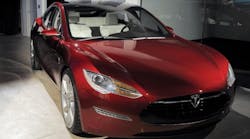A previously unidentified variety of dog: That is what the first autopilot-equipped Australian Tesla’s Nvidia system reported when it encountered a kangaroo. A few thousand web-sourced videos and a matter of days later (it could have been hours), every Tesla in the world knew what a kangaroo was, how to anticipate its potential trajectories and how to avoid one on the road.
Technologies from MobilEye, Nvidia, VocalZoom, Quanergy and a host of others are fundamentally reshaping the automotive industry in a revolution initiated by the likes of Tesla, Google and Uber and now taken up by all. In the last month, General Motors invested in Lyft, bought Cruise Automation and announced a Cruise-enabled, autonomous GM Lyft vehicle. The next day, Fiat Chrysler announced it is partnering with Google on an autonomous minivan.
There are five key lessons aerospace and defense executives should take as we watch—and benefit from—the ongoing revolution in automotive:
• Sensors are about more than situational awareness. The power of the kangaroo story is not in the first vehicle’s first encounter. On that day, the car successfully maneuvered past the unknown “dog.” Most important, that car is a single node in a deep-learning network. Like its tens of thousands of peers, each vehicle’s encounter with a previously unknown risk—and each deviation a human driver makes from its expectations—is captured, uploaded and evaluated against the total fleet’s experience, to upgrade fleetwide capabilities in near real-time. Imagine the battlefield implications of shifting from voice-to-voice, post-action reviews to squadrons of assets learning to adapt and better guide their crews.
• Beware asynchronous innovators. The current revolution in the automotive industry was launched by outsiders. In a successful, supposedly mature market, it can be remarkably difficult to identify and launch a technology revolution. There are too many existing models to challenge, too many existing profit flows at risk and too little certainty of a better outcome for risk-takers. While the traditional automotive base is responding rapidly and many companies will significantly advance their businesses, many new players have successfully entered and some incumbents will likely fall as a result. A key lesson learned from the automotive industry’s fast response to the new world is to maintain a keen awareness of the new capabilities being brought to market in the venture community or by non-traditional suppliers.
• Look beyond product platforms to platforms of products. The automotive sector is rapidly experimenting to migrate from “smart connected products” (autonomous vehicles, learning and upgrading as a fleet) to “smart fleets” (algorithms that allow those vehicles to coordinate activity, for instance drafting each other or platooning on highways to improve fuel economy) and, ultimately, to “platforms of products,” which may tie together personal vehicles, traffic-control infrastructure, nomadic devices, mobility services and mass transit to eliminate the traffic jam with seamless multi-modal transport options. Envision the potential for smart connected product solutions to make obsolete the long-stalled next-generation air traffic control, or to unlock the next level of battlefield integration.
• Product companies will win in a world of smart products. Even Internet players like Google are building physical cars, not just placing their bets on providing software and connectivity. The power being unlocked in the current revolution is indirectly linking broad networks of product-embedded sensor platforms through deep-learning algorithms to improve the product’s real-world engagement.
• Search deeply for ripe technologies outside the traditional base. The unfolding revolution in the automotive industry is less about primary research and invention than about development—spotting and bringing together an array of externally sourced sensor, actuator, computing and connectivity technologies around the vehicle and the driving experience. In today’s technology marketplace, sensing the ecosystem becomes an increasingly core component of the MR&D agenda.
We are at a unique point in history. There are a plethora of ripe technologies to be harvested and applied across aerospace and defense. Huge value will be created by those with the prescience to actively look outside A&D, ask “what-if” and identify high-value applications. Carpe diem.
Tom Mayor is the industrial manufacturing strategy practice leader at KPMG.




